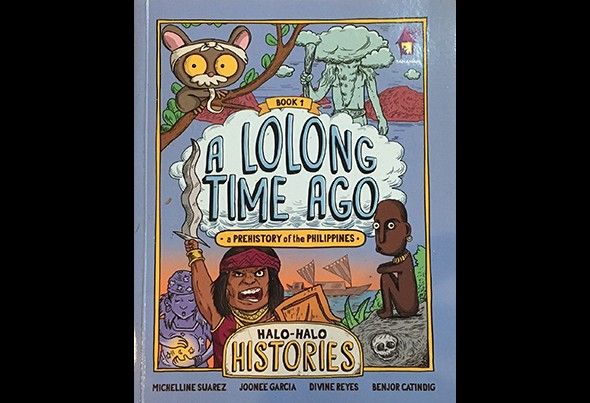History as happy ‘halo-halo’


Who doesn’t love a good story?” That’s the first line of text that one gets to read in this book. A rejoinder comes in the adjacent comic-book-type panel: “And who doesn’t love a good story about yourself?” A connected lower balloon adds: “I mean, it’s like a selfie with words.”
Any reader would then surmise that what follows will be further levity that owes much to present-day disposition.
A subsequent panel reads: “When the subject of studying history comes up, some of us might yawn — sad, but true. That’s because sometimes we forget that the people we learn about were almost just like you and me, except we have video games and cooler shoes.”
In A Lolong Time Ago: A Prehistory of the Philippines, written by Michelline Suarez, Joonee Garcia, and Divine Reyes, illustrated by Benjor Catindig, and published by Tahanan Books for Young Readers, it is actually Philippine prehistory that’s presented as an entertaining parade of bite-sized features.
It’s an entirely welcome departure from what might customarily intimidate young people with turgid chunks of text. The hark-back tweaking comes with comic-book-type sketches and informative photos, and is ushered in with a fresh perspective with the flash-forward infusion of today’s idioms and points of awareness, indeed of contemporary familiarity.
The authors’ note acknowledges at the outset: “We — the people who wrote this book — are authors. We are not historians. We are, however, avid readers who share an interest in history, especially as it concerns the Filipino people, and what we want to do is tell you what we know in a way that you will understand. We’ve broken it all down into manageable chunks of information that we hope you find funny and entertaining and enlightening.”
We may call it the millennial-ization of the past as it has been previously recorded, from “Creation Myths We Told Ourselves (Once Upon a Dahon)” to “The Truth About Our Origins (Exposed!)” and so on, to the final “Chapter 8: Lifestyles of the Precolonial (Fashion, Art and Culture)” plus an “Epilogue.”
Intervening chapters are titled thus: “My Lolo Was a Caveman (The Very First Filipinos)”; “When Lola Planted Rice (The Neolithic thru Metal Ages)”; “Row, Row, Row Your Balangay (Inter-Island Travel and Trade)”; “Datu Puti Was Kayumanggi (The Emergence of Sociey)” and “Life in These Islands (Buhay sa Bahay ni Kuya Atbp.)”
Factoids come in the form of “Tsitsirya” — even more bite-size info that supplements the educational narrative, such as the following: “The supreme god of the Tagalogs was called Bathala (a.k.a. Maykapal). Its equivalent was Kaptan to the Visayans, Gugurang to the Bicolano, and Gutugutumakkan to the Agta. Now say that three times fast!”
Early on, too, three invented characters are introduced as commentators providing asides for the prehistory lessons: Tatang Tarsier, Bembol Bulul, and Datu D2, each of whom comes with a whimsical bionote, and their respective data with regards “Fun Facts, Motto, and Hobby.” Of the last, Tatang Tarsier’s is “Staring contests,” while Bembol Bulul’s is “Eavesdropping” and Datu D2’s is “Sharpening swords, making new laws, and yo-yo target shooting.”
Bilingualism serves as a bridge for popularization, as much as the tongue-in-cheek jokes that ring a brighter bell for attention and comprehension. On the page following the epilogue is a drawing of Magellan and Datu D2 (who could well be Lapu-Lapu) and his cohorts. “I discovered you,” says the former. The rejoinder: “TekaMOMENT. Aren’t you the one who’s lost?”
This thoroughly charming book, the first of what’s billed as “Halo-Halo Histories,” relies much on a light-hearted touch, but also offers simple equations and stabs at insight proceeding from commonsensical conjectures.
“Because our islands were so conveniently located, we experienced a lot of through traffic. As waves of people visited, some passed through and moved on to other parts of the Pacific. But some decided to stay and call our islands “home.” They intermarried, put down roots, and integrated into the local communities. These early pioneers may have established their roots here but at the same time, their maritime skills combined with our central location encouraged a lot of traveling. Our ancestors got around!
“We’re thinking this is why Filipinos are known throughout the world to be friendly and adaptable people. We like visitors! And we like migrating to other parts of the world, too. Old habits die hard!”
An eight-page full-color folio displays “National Cultural Treasures” that include the Manunggul Jar, the Maitum Burial Jar, Calatagan Ritual Pot, Laguna Copperplate, and Ancestral Gold items such as the Golden Tiara of Agusan, a death mask, a funerary mask, a decorative breastplate and other gold ornaments. Another full-color insert shares eight pages from The Boxer Codex.
“Tattoos: The Art Gallery You Take With You” is featured as part of the final chapter on lifestyles. It shows a photo of Whang-Od Oggoy, the last living Kalinga traditional tattoo artist, presently expected to be named a National Living Treasure.
“Literature: Precolonial Movie Night!” serves up “The Life of Lam-ang” and “Darangen” as samples of an epic poem and an ancient song, Ilocano and Maranao, respectively. “Something like the teleseryes of today.”
The Darangen Epic has “17 cycles and a whopping 72,000 lines! Like a Filipino movie, it’s got something for everyone: historical and mythological episodes, politics, romance, laws, standards, social values, and everything in between. It is rich, complicated, massive and… well, EPIC!”
This feel-good book serves up manifold points of Pinoy pride in our passage through millennia that can be compressed into a mix-mix matrix that isn’t quite make-believe.
Coming next for what is billed as “Halo-Halo Histories” are “Bayani Babes: Famous Women in Philippine History” and “Show Me the Money!: Who’s Who on our Philippine Currency.”
We can look forward to more delightful tweaking as heirs to light-hearted history.



















